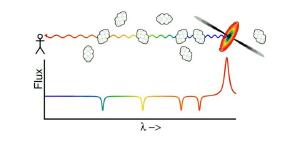Blog
Missing Ingredient
22 July 2014
 Universe Review
Universe ReviewThere’s been a bit of press regarding “missing light” in the universe. It all starts with a recent paper in the Astrophysical Journal Letters.1 Most of the popular articles spin things as missing light because that was the spin of the press release, but the actual work is more subtle, and more interesting.
In this work, the team looked at the distribution of neutral hydrogen in the universe. They did this by looking at what is known as the Lyman-alpha forest, which is a series of absorption lines seen in light from quasars and other distant active galactic nebulae. Basically, as the light from a distant quasar (which is highly redshifted) passes through interstellar clouds that are closer (and less redshifted) a series of absorption lines appear in the spectrum. This “forest” of absorption lines is known as the Lyman-alpha forest. The team did a statistical analysis of various quasar observations, and from that determined the amount of neutral hydrogen in the universe at various distances (redshifts).
Neutral hydrogen is the most common ingredient of interstellar gas, but it is also sensitive to UV light. Ultraviolet light can ionize neutral hydrogen, and the more ultraviolet light there is, the more ionized hydrogen you would expect. There are lots of sources of UV light in the universe, and together they form what is known as the cosmic ultraviolet background. The team compared the amount of neutral hydrogen observed with the cosmic ultraviolet background, and found that there is more ionized hydrogen than could be accounted for by the cosmic UV background. Specifically, what they found was that the higher the redshift (thus, the greater the distance from us), the better the two agreed. It is only in the “local” region of the universe that they don’t agree. They don’t agree by about a factor of 5, which is pretty significant.
One way to state this discrepancy is to say that there is “missing” ultraviolet light in the local universe, hence the popular articles. But it could also be the case that we haven’t accounted for all the local sources of UV radiation. There could be ionizing sources that we don’t see directly due to dust, for example. It could also be the case that the statistical models are wrong, though it is hard to see how they would be wrong by a factor of 5.
Of course whenever this kind of oddness shows up, there are always more exotic proposals, such as the idea that dark matter might decay to produce ultraviolet light. But that is really speculative. At this point what we can say is that something is ionizing hydrogen gas in the local universe. Whether it is some unseen source of UV light, or some other mechanism is yet to be determined.
Kollmeier, Juna A., et al. “The photon underproduction crisis.” The Astrophysical Journal Letters 789.2 (2014): L32. ↩︎